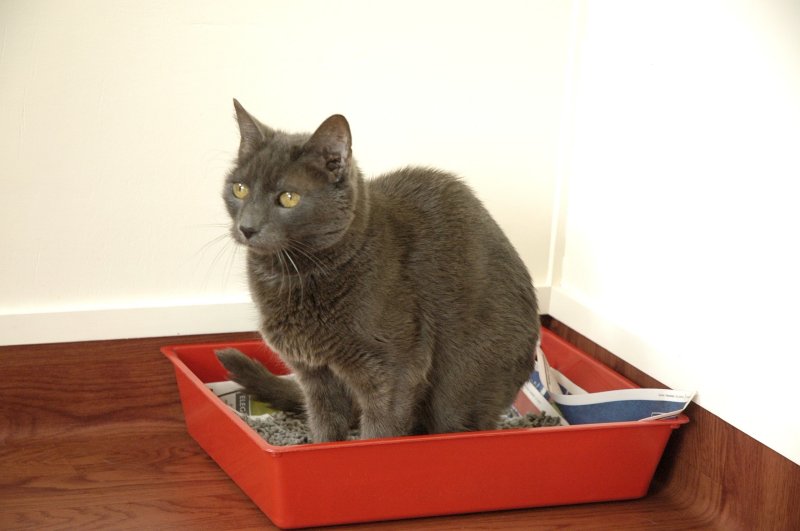Soiling indoors (urinating and defecating in the wrong place)
The cat is usually a very clean animal and will consistently use a litter tray indoors if provided, or loose earth or sand outside in the garden.
Occasionally a one-off accident can occur if a cat is ill, trapped in a room or suddenly frightened. If inappropriate urinating or defecating in the home persists it should be investigated by a vet to rule out a medical problem.
Whatever the cause, punishment is not the answer. Deterrents, such as aluminium foil, pepper, citrus peel or a water pistol will only redirect the behaviour to another site.
The difference between urine spraying and inappropriate urinating
Depositing urine for scent marking is very different from urinating to relieve a full bladder. This is why it’s important to find out if your cat is spraying or urinating, as the solutions vary.
To urinate, your cat squats and deposits a volume of urine on a horizontal surface. It then often scratches at the area around the urine. Common sites for inappropriate urinating are carpets, sofas, duvets, baths or sinks.
To spray urine, your cat stands up, usually making a treading motion with his back feet, quivers its tail and a small amount of urine is sprayed backwards onto a vertical surface such as a wall, leaving an obvious scent mark. Common sites for spraying are doors, windows, around cat flaps, curtains, electrical equipment and rubbish bags.
Once you have found out which of the two your cat is doing, it is necessary to take action to resolve the behaviour. See our separate section on urine spraying for more information.
Cleaning the soiled area
Once your cat has urinated or defecated at a particular location, its sensitive nose will encourage it to use that place as a regular toilet.
The best way to break the habit is to keep your cat away from the area as long as possible, remove any smell that it can detect and maybe block access to the location.
Wash the area with a 10% solution of biological or enzymatic washing powder, rinse with cold water (don’t use too much liquid) and allow the area to dry thoroughly. Once dry, spray it lightly with surgical spirit (using a plant mister), scrub gently, and leave to evaporate.
Reasons for soiling indoors
Some of the more common reasons for soiling indoors are:
Illness
Urinary tract disease or diarrhoea can cause soiling, as your cat is either in discomfort or just can’t make it in time to the litter tray or outside. Any illness or pain can be associated with soiling, so an early examination by your vet is important, particularly if you notice your cat straining unproductively and/or passing small amounts of urine frequently. A form of urinary tract disease that is stress-related (‘feline idiopathic cystitis’) is less obvious in its presentation, but one common symptom is urinating outside the litter tray.
Cats often benefit from increased fluid intake if they suffer from recurrent cystitis. This may require your cat to change from a dry diet to a wet one or to be put on a prescription diet to prevent recurrence. If successfully treated, your cat will return to its normal acceptable pattern of toileting.
Dirty litter tray
Cats are very clean animals, and if the litter tray is dirty, they look elsewhere for a place to go. Think of how you felt the last time you were faced with a dirty public toilet and you can probably empathise. Clean the litter tray frequently – twice a day is ideal – and make sure that it’s completely scrubbed clean and aired out on a weekly basis. For multi-cat households the rule of thumb is one litter tray for each cat plus one extra.
Wrong cat litter or litter tray
Using scented cat litter, deodorants or disinfectants with strong smells could put your scent-sensitive cat off using its litter tray. It may object to walking on the uncomfortable surface of certain cat litters, like crystals. If you want to change the type you use, mix the new one in gradually over a week, or place a new tray with the new cat litter alongside and allow your cat to choose.
At Cat Hotel Stoney Creek we use ‘Breeder’s Celect’ cat litter, made out of recycled paper, which most cats seem to prefer. We use a scoop to remove solids and wet litter patches, then replace the newspaper underneath (two layers is enough) and top up with fresh litter.
Your cat may prefer the security of a covered tray or prefer an open tray as it offers more options for escape. Some covered trays have flaps over the entrance and these can be one obstacle too many for your more insecure cat.
Wrong location of litter tray
Your cat’s litter tray should be away from his food and water dishes (you don’t eat near the toilet, so why should your cat?) and in a place where it can get to easily and feel safe in. Consider the location from your cat’s point of view: choose a quiet spot where it can see what’s coming at it. A cat doesn’t want any surprises while it is in the tray.
Link:
https://icatcare.org/advice/soiling-indoors/
